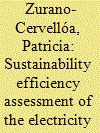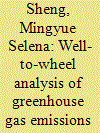|
|
|
Sort Order |
|
|
|
Items / Page
|
|
|
|
|
|
|
| Srl | Item |
| 1 |
ID:
150473


|
|
|
|
|
| Summary/Abstract |
The gradual trend towards the electrification of economies has raised new challenges. Focusing on France, this paper uses monthly data from January 2010 to November 2014, to study the challenge of the simultaneous integration of various sources of generation, and their relationship with economic growth. For the analysis of the dynamics of interaction between electricity sources, the auto-regressive distributed lag (ARDL) bounds test approach was shown to be appropriate, as it allows short- and long-run effects to be distinguished. The results showed that nuclear energy has been a huge driver of economic growth in France and, at the same time, leads to an environment with lower CO2 emissions. Renewables were shown to exert a negative effect on economic growth, which could be due to lack of investment in other sources of production, due to the resilient position held by nuclear sources. The substitution effect among sources is noticeable. The robustness of the results was checked using annual data, from 1970 until 2012, and the results were comparable to those from the monthly data.
|
|
|
|
|
|
|
|
|
|
|
|
|
|
|
|
| 2 |
ID:
166436


|
|
|
|
|
| Summary/Abstract |
Hydroelectricity provides approximately 65% of Brazil's power generating capacity, making the country vulnerable to droughts, which are becoming increasingly frequent. Current energy law and policy responses to the problem rely on a sectorial approach and prioritise energy security and market regulation. Brazil has opted to increase energy security levels during periods of hydrological variability with national grid interconnection and thermal plants backup. Additionally, Brazil has created the Energy Reallocation Mechanism (MRE) to manage the generators’ financial impacts in times of insufficient water. This policy, however, was unable to avoid the high financial exposure of generators in the spot market during the severe droughts experienced in the period 2012–2016.
|
|
|
|
|
|
|
|
|
|
|
|
|
|
|
|
| 3 |
ID:
098586


|
|
|
|
|
| Publication |
2010.
|
| Summary/Abstract |
Despite recent consumption decrease due to recession, European electricity sector is struggling to reach ambitious targets for reductions of greenhouse gas emissions. Our objective is to carry out a macro analysis of the energy mix in two European countries: Belgium and Spain. Life Cycle Assessments are carried for 2005 as well as for seven possible referenced scenarios to reach EU and also national legal objectives at the horizon 2020 and 2030. Ambitious renewable energy sources' deployment plans can decrease impacts on the environment significantly as those sources replace polluting traditional sources, such as coal/lignite, oil or gas. When concentrating on projections for the future in Spain, results show that a mix with little coal and oil replaced by up to 54% of RES-E energy sources could bring environmental benefits with CO2 emissions equivalent around 0.2 kg per kWh produced (compared with 0.54 kg in 2005). In Belgium, all future scenarios presented include more coal and gas with a limited share of RES-E; those mixes present more environmental harmful impacts (up to 0.56 kg CO2 equivalent). This is why RES-E deployment is crucial as long as it is part of an electricity mix with reduced quantities of traditional fossil fuels.
|
|
|
|
|
|
|
|
|
|
|
|
|
|
|
|
| 4 |
ID:
169738


|
|
|
|
|
| Summary/Abstract |
Assessing the sustainability level of the power sector can aid the transition towards a sustainable energy system. In this contribution, we propose a novel approach to compare and optimize electricity mixes according to sustainability criteria and apply it to the 28 EU members. Our method combines life cycle assessment, data envelopment analysis (DEA) and rigorous mathematical programming tools in three main steps. Firstly, DEA is applied to assess the efficiency level of electricity mixes of EU member countries considering the three dimensions of sustainability. Then, electricity portfolios of inefficient countries are optimized by solving a model that seeks to attain the targets provided by DEA while simultaneously considering the technical aspects governing electricity generation. This model, which constitutes the cornerstone of our approach, complements standard DEA by ensuring realistic and meaningful targets. In the third step, we evaluate the electricity portfolios optimized previously by running DEA again. Our results suggest that energy policies in the EU should favor the deployment of hydropower, wind and solar, while simultaneously displacing non-renewable sources and bioenergy. The deployment of carbon capture and storage is also a potential alternative that could be incentivized via policies worded in terms of carbon intensity targets.
|
|
|
|
|
|
|
|
|
|
|
|
|
|
|
|
| 5 |
ID:
181425


|
|
|
|
|
| Summary/Abstract |
Electric Vehicles (EVs) are regarded as a feasible solution to achieving decarbonisation in the transportation sector. However, EVs powered by fossil dominated energy sources may offer a discounted solution. This paper presents a comparative study of Australian and New Zealand’s vehicle markets on Greenhouse Gas (GHG) emissions and energy consumption using well-to-wheel analysis. A vehicle uptake projection model is proposed to predict future uptake of EVs and associated emissions under three scenarios with different mix of EVs. Our empirical results suggest that, with the current electricity mix, in terms of energy consumption, Battery Electric Vehicles (BEVs) perform better than other types in New Zealand and Australia. Emission wise, BEVs emit 90% less GHG than the second-best option Plug-in EV in New Zealand, and 40% less than the second-best, Fuel Cell EVs (FCEVs), in Australia. In the long run, as more “green hydrogen” is produced, FCEVs will play a critical role in minimising emissions. Emissions in the two countries are predicted to reach their peak around 2030, provided that BEVs form the major portion of the EV mix with a higher penetration of renewables and more FCEVs enter the fleet. The empirical outcomes provide important policy insights to support decision making.
|
|
|
|
|
|
|
|
|
|
|
|
|
|
|
|
|
|
|
|
|